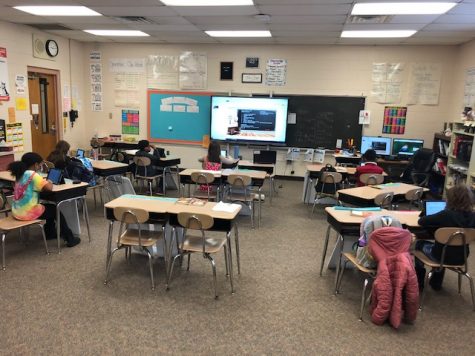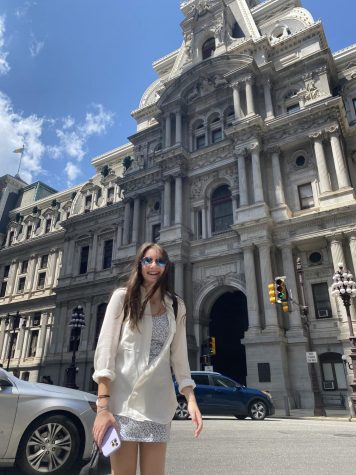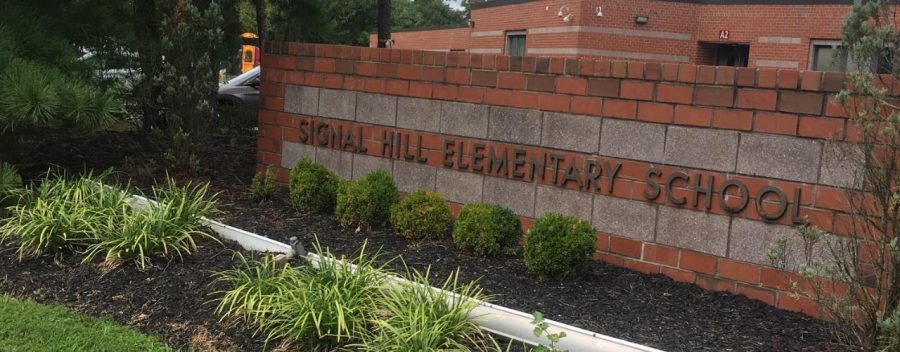Local elementary teachers transition quickly to online learning
Signal Hill follows the same guidelines as the rest of the schools in the Voorhees Township School District. Students must join the Google Meet with their cameras on and microphone off. The students have a choice of being fully remote or hybrid, but currently the district is fully remote until January.
In the end, the teachers really just want to maintain communication with their students. Mr. Seppanen has returned to his core of community-based teaching. As long as he has this communication, he’s ok with doing less of the academic work he’d do in a normal school environment. “I’m ok with doing a little less as long as I’m sticking to my primary purpose which is building a community with my kids and making sure they’re learning and growing.”

As the number of COVID-19 cases continues to rise, so does the uncertainty of the past eight months. One thing that is certain, however, is that kids will continue to learn, no matter if it’s remotely or in-person.
When Shawn Seppanen, a fourth grade teacher at Signal Hill Elementary School, first got the call that school would be shutting down for two weeks on Friday March 13, he was just thinking about getting through Monday.
“I was relieved because of the health aspects of it, but as a professional my mind was racing,” he said.
Mr. Seppanen has been teaching at Signal Hill for eight years. “I really like that fourth-fifth grade age group,” he said. “Kids are old enough where I can give them responsibility, they get my jokes, but they’re also young enough that they’re joyful and impressionable.”
Jaclyn Eskenas had a similar reaction on Friday March 13. She expected the shut down to last about a month, so she printed 3 weeks worth of worksheets and scanned textbook pages to send home with her fifth grade students. “I was nervous, but I was prepared to have the kids do what they needed to do,” she said.
This year looks a little different for Mrs. Eskenas. She has been teaching fifth grade at Signal Hill for 11 years now and loves her students “enthusiasm in regard to school.” Instead of having her normal fifth grade class this year, Mrs. Eskenas is teaching the Enrichment Program.
Students must qualify for the class through intelligence, creativity, and academic test scores. She’s also teaching Sparks where students are identified through teacher recommendation and test scores. “Every child really loves to do their work.”
Signal Hill follows the same guidelines as the rest of the schools in the Voorhees Township School District. Students must join the Google Meet with their cameras on and microphone off. The students have a choice of being fully remote or hybrid, but currently the district is fully remote until January.
As a fourth grade teacher, Mr. Seppanen has a normally hybrid class. He tries his best to give his students breaks throughout the day. “As an adult staring at a screen that long isn’t good for you but especially for developing eyes.”
As the year has progressed, the students have gotten better at being on the Google Meet when they are supposed to. “With elementary school kids, it’s about consistency, so I try to do the breaks at the same time every day.”
Because the Enrichment Program (EP) only meets for an hour and a half a week, the class is fully remote. This means they can only meet on the fully remote day which typically falls on Wednesday when there is hybrid instruction. “Every child joins at their scheduled time, they complete all their work, and they really enjoy it,” she says about her EP and Sparks students.
“Engagement starts with interest,” Mr. Seppanen said. “I teach with excitement and passion because I want my kids to see that I’m interested in what we’re learning because that’s the best way for them to be interested.” He also implements a reward system where students can earn virtual points and get digital rewards, like changing the clothes of his Bitmoji. To keep up engagement, he uses a virtual spinning wheel with all the students’ names on it to make participation seem like a fun game.
Participation is essential for these students. “The students with the best grades are usually the ones that participate the most, Mrs. Eskenas said. In high schools, participation is down because of the remote aspect. Many students don’t feel comfortable turning their cameras on or talking to the class over Zoom.
Mrs. Eskenas’s students are all eager to participate. “Since they are happy to be chosen for the programs, I do not have any trouble with participation and do not have to provide additional incentives,” she says. She, like Mr. Seppanen, tries to keep her lessons as short as possible, so it doesn’t seem like a lecture to the students. After a mini lesson, the students unmute themselves and are able to talk freely about what they learned. If they’re not having discussions, they’re working on projects.
Projects have been a major challenge in the virtual classroom. “Projects that would have been group projects are now individual projects,” Mrs. Eskenas said. “That level of collaboration is difficult to get to, so I’ve tried to implement team building activities like escape rooms. ” The Enrichment Program typically has a major aspect of team building to it, but like Mrs. Eskenas said, collaboration right now is hard. Mr. Seppanen has had the same problem; group work isn’t very feasible right now.
“I’m hoping to bring breakout rooms into the classroom and start doing group work again,” Mr. Seppanen said. Both teachers have started experimenting with the breakout room feature, but it’s hard with younger kids. Teachers can’t be in multiple rooms at once, so they just have to trust the kids are staying on topic with their work.
In addition to changing projects to be individual, teachers also have to think about supplies. “I have modified many projects to use minimal materials and materials that can ordinarily be found around the house,” Mrs. Eskenas said. Mr. Seppanen typically sees students throughout the week, so he can give the hybrid students supplies when they’re in the classroom, but for the remote kids, they need to get their own materials. “If it’s a multiday assignment I have to make sure that if they start the assignment here they would have the supplies to finish it at home.,” he said.
Before Mrs. Eskenas was printing packets on that Friday in March, she coincidentally had training on Google Suite the month before. She had a Google Classroom set up for her class but wasn’t very familiar with it.
Her biggest struggle last year was with technology.
“I spent endless hours learning all about the best practices for virtual learning,” she said. “I made tutorial videos for my students to teach them how to use Google Classroom for assignments.” She was primarily teaching through recorded lessons and used Google Meet to check in with her students and provide one-on-one instruction to whomever needed it. This year, she has switched to solely using Google Meet and Google Classroom.
Mr. Seppanen and his students had been using Google Classroom throughout the year when Signal Hill shut down last spring, but that didn’t make virtual teaching any easier. “Teachers will tell you how much they’re questioning everything,” he says.
The uncertainty of the world right now allows us all to be more lenient. As a perfectionist, this time has forced Mr. Seppanen to accept that there really is no such thing as perfection, especially in this environment.
“In a typical year, I expect myself to be perfect, but I haven’t defined this perfection. No matter how well I did, I feel like I could’ve done better. [This year] I’m not holding myself to this undefined, unattainable, nebulous goal that I have. I’m more able to accept that I’m doing the best I can.”
This time is all about finding other ways to utilize your strengths, and maybe even turn some weaknesses into strengths. “The fact that I’m able to be flexible and pang around my attention, that’s been really helpful,” Mr. Seppanen says. He’s able to bounce his attention between his students in his classroom and on Google Meet.
In the end, the teachers really just want to maintain communication with their students. Mr. Seppanen has returned to his core of community-based teaching. As long as he has this communication, he’s ok with doing less of the academic work he’d do in a normal school environment.
“I’m ok with doing a little less as long as I’m sticking to my primary purpose which is building a community with my kids and making sure they’re learning and growing.”



